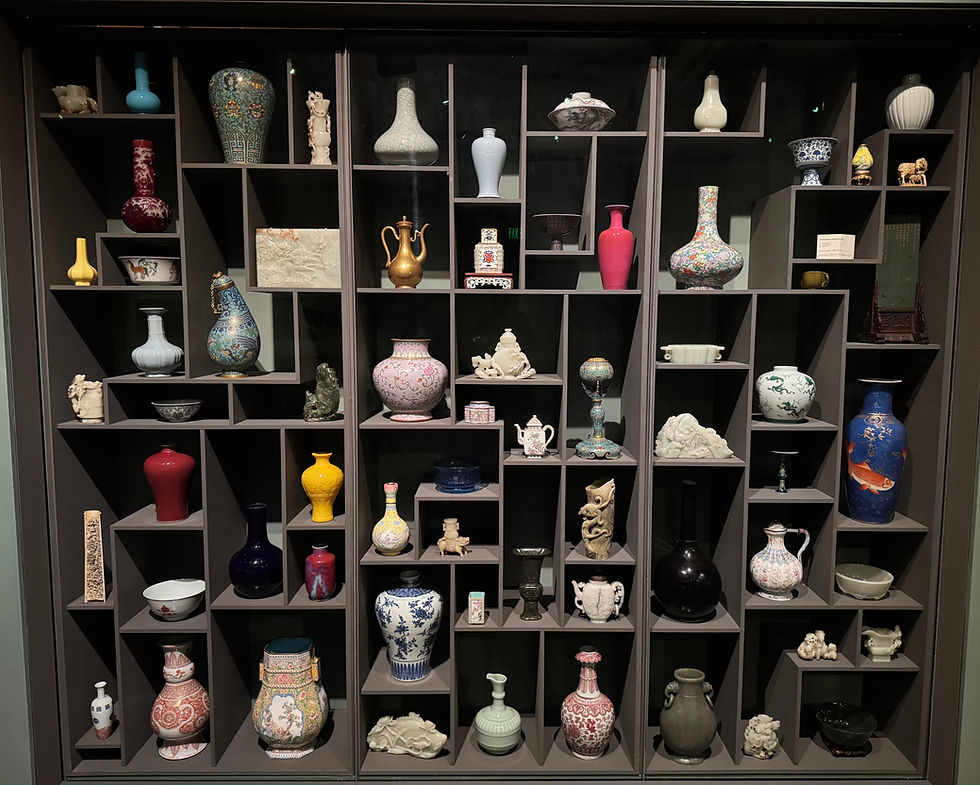Chinese Art Library 101
- Anthony Wu

- May 15, 2017
- 4 min read
One of the prerequisites for my work is to have a strong Asian Art reference library - this is necessary for tasks such as writing an article, researching and finding comparables for a specific item, or checking for provenance.
For those of you who visited my Toronto office, you have probably seen my research library and the hundreds of catalogues and books from international auctions, museums and dealers that are contained in over five Ikea Billy bookcases (note: Billy bookcases are only a temporary solution for storing heavy books! The shelves tend to sag over a couple of months so I will eventually be looking for a more permanent solution).
The books and catalogues I have in my office are typically ones I most often use - these are volumes I will typically take out every couple of weeks or months. By art subject, I would estimate my office library to be 75% Chinese, 10% Himalayan and Indian, 10% Japanese, and 5% Korean and Islamic. (I have another twelve Billy bookcases full of books and catalogues in an offsite storage area that balance out the numbers).
Anyways, one really doesn't need hundreds of books and catalogues to appreciate Asian Art. If you haven't started collecting books yet, here are a few suggestions for starting a modest Chinese art library.
Start with the general surveys, then move to the more specific categories that you like i.e. porcelain, Buddhist sculptures, paintings and/or furniture. Old auction catalogues are always useful for provenance searches (and to laugh at how 'cheap' Chinese art was 30 years ago), but the prices will be extremely outdated. Even the more recent catalogues will have outdated prices within three to five years. These are just some suggestions, and I've listed three useful Chinese Art surveys I used when starting out in this field thirteen years ago.
1. The Royal Ontario Museum. Homage to Heaven, Homage to Earth: Chinese Treasures of the Royal Ontario Museum. Toronto: University of Toronto Press, 1992.
This is probably one of the first books on Chinese Art I opened up, mostly because it dealt with the ROM's collection which was easily accessible to me location-wise. In addition to a history of the museum's massive collection of Chinese art, it provides a solid survey of the history of China through its material art culture. The chapters are broken into categories including 'Jades and Hardstones', 'Ceramics' , 'Burial Figures', and 'Painting'. The large colour photos were also extremely useful. This hardcover volume is fairly easy to find in second-hand Toronto bookstores and on the internet. In my opinion, it is one of the better volumes on Chinese Art the ROM has published in their 103 year history. (Note: on the cover, a Sancai Ceramic Figure of Yanluo, the King of Hell, dated to 1523 of the Ming Dynasty)

2. Jessica Rawson, Ed. The British Museum Book of Chinese Art. London: Thames and Hudson, 1992.
This is another extremely useful survey of Chinese Art from one of the world's most important museums. It is an excellent source for learning more about the history of China through art with chapters including 'Jades and Bronzes for Rituals', 'Decorative Arts for Display', 'Ceramics for Use' and 'Luxuries for Trade'. The images are split between colour and black and white. When I first started out in this field, I found the most useful part of this book to be the reference material in the back which includes chronologies and highlights from each dynasty, important archaeological sites, a listing of important painters, and a concise glossary for Chinese art historical terms. I have the softcover edition, and I actually don't know if this was produced in a hardcover format. It is fairly common and can easily be found on the internet. (Note: on the cover, detail of a Large Cloisonné Enamel 'Dragon' Jar with a Ming Dynasty Xuande Mark and of the Period (1426-1435)).

3. William Watson. Art of Dynastic China. New York: Harry N. Abrams, Inc., 1981.
This massive book contains over 600 pages and is one of the essential surveys of Chinese Art. At the time of publication, it was 'state-of-the-art' with its comprehensive new research and use of large, high-quality colour plates - many of which fold out! The images are items from international museums and archaeological sites and the chapters are divided thematically with sections including 'Early Traditions', 'The Hieratic Cycle', 'Realistic Art', 'Architecture', etc, with further, more detailed sub-categories. The second part of the book contains hundreds of black and white photographs of top Chinese works of art from around the world - perfect for testing your identification skills! The tome ends with a useful listing of archaeological sites and a glossary. The author William Watson was the former keeper of the Percival David Foundation at the University of London. This book is hard cloth cover with paper wraps and at the time of this blog, the average online price is about 50 CAD (approximately 35 USD). (Note: on the cover, detail of a Large 'Double Phoenix' Kesi Panel from the Late Ming Dynasty, Circa 1600, from the Victoria and Albert Museum, London).

Anyways, let me know if this was a helpful blog. Questions, comments and more recommendations can be sent to my email anthony@anthonywuart.com. I'm hoping to link my blogs to Facebook in the coming weeks so email is probably the easiest way to contact me at the moment. In the future I will try to write more blogs about interesting books on Asian Art subjects in addition to my Asian Art adventures and current projects.




Comments